Great Planes GPMA1570, GPMA1571 User Manual
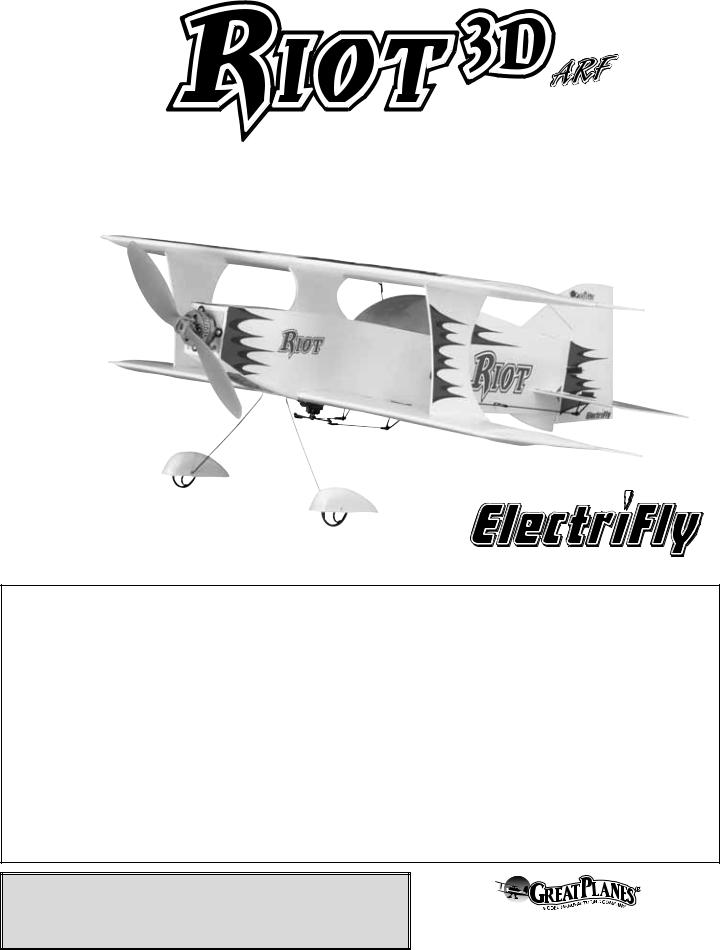
™
INSTRUCTION MANUAL
Wingspan: 20.5 in [514mm] Wing Area: 235 sq in [15.2dm2]
Weight: 7.4 – 8.0 oz [210 – 225g]
™
Wing Loading: 4.5 – 4.9 oz/sq ft [14 – 15g/dm2] Length: 22.75 in [580mm]
Radio: 4-channel with 3 micro servos
Motor: RIMFIRE™ 28-22-1380kV brushless out-runner
WARRANTY
Great Planes® Model Manufacturing Co. guarantees this kit to be free from defects in both material and workmanship at the date of purchase. This warranty does not cover any component parts damaged by use or modification. In no case shall Great Planes’ liability exceed the original cost of the purchased kit. Further, Great Planes reserves the right to change or modify this warranty without notice.
In that Great Planes has no control over the final assembly or material used for final assembly, no liability shall be assumed nor accepted for any damage resulting from the use by the user of the final user-assembled product. By the act of using the user-assembled product, the user accepts all resulting liability.
If the buyer is not prepared to accept the liability associated with the use of this product, the buyer is advised to return this kit immediately in new and unused condition to the place of purchase.
To make a warranty claim send the defective part or item to Hobby Services at the address below:
Hobby Services
3002 N. Apollo Dr., Suite 1
Champaign, IL 61822 USA
Include a letter stating your name, return shipping address, as much contact information as possible (daytime telephone number, fax number, e-mail address), a detailed description of the problem and a photocopy of the purchase receipt. Upon receipt of the package the problem will be evaluated as quickly as possible.
READ THROUGH THIS MANUAL BEFORE STARTING CONSTRUCTION. IT CONTAINS IMPORTANT INSTRUCTIONS AND WARNINGS CONCERNING THE ASSEMBLY AND USE OF THIS MODEL.
Champaign, Illinois
(217) 398-8970, Ext 5 airsupport@greatplanes.com
Entire Contents © Copyright 2006 |
GPMZ1570 for GPMA1570/1571 V1.0 |
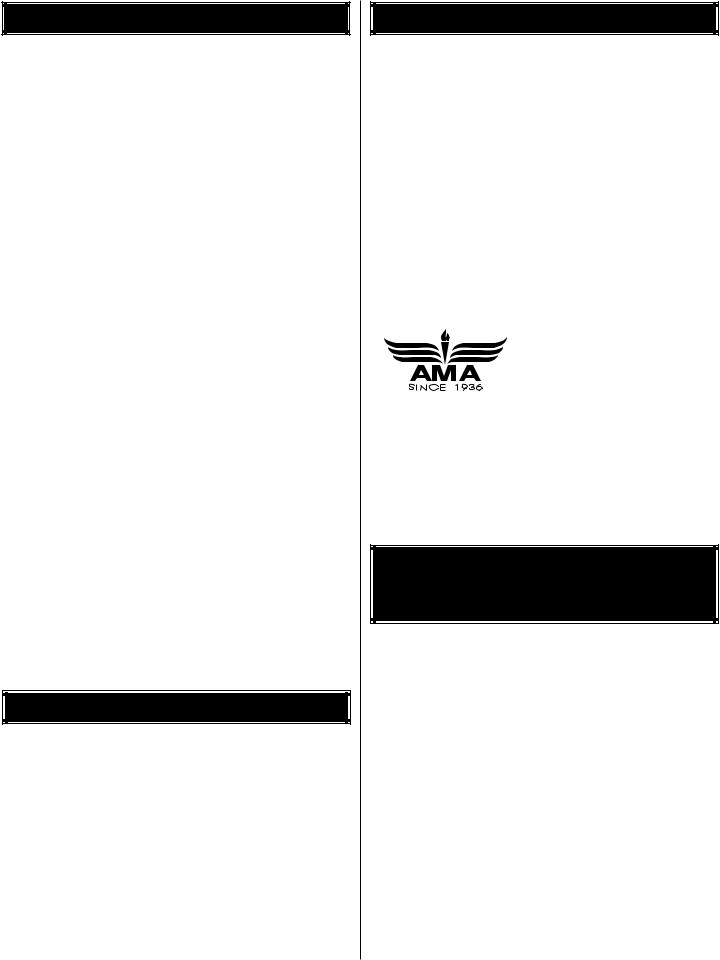
TABLE OF CONTENTS |
|
INTRODUCTION ............................................................... |
2 |
AMA................................................................................... |
2 |
SAFETY PRECAUTIONS.................................................. |
2 |
LITHIUM BATTERY HANDLING & USAGE ..................... |
3 |
RADIO EQUIPMENT......................................................... |
3 |
ADDITIONAL ITEMS REQUIRED..................................... |
3 |
Adhesives & Building Supplies.................................... |
3 |
Optional Supplies & Tools ........................................... |
3 |
IMPORTANT BUILDING NOTES ...................................... |
4 |
COMMON ABBREVIATIONS............................................ |
4 |
METRIC CONVERSIONS ................................................. |
4 |
METRIC/INCH RULER ...................................................... |
4 |
KIT INSPECTION .............................................................. |
5 |
KIT CONTENTS ................................................................ |
5 |
ASSEMBLE THE FUSELAGE........................................... |
6 |
Install the Tail Surfaces................................................ |
6 |
Mount the Wings ......................................................... |
7 |
RADIO SYSTEM INSTALLATION..................................... |
9 |
Install the Servos & Pushrods..................................... |
9 |
Motor & ESC Installation ........................................... |
11 |
Battery & Receiver Installation .................................. |
12 |
ATTACH THE MAIN GEAR ............................................. |
12 |
ATTACH THE PROPELLER ............................................ |
13 |
APPLY THE DECALS...................................................... |
13 |
GET THE MODEL READY TO FLY ................................. |
13 |
Check the Control Directions .................................... |
13 |
Set the Control Throws.............................................. |
14 |
Balance the Model (C.G.).......................................... |
14 |
Balance the Model Laterally...................................... |
15 |
PREFLIGHT..................................................................... |
15 |
Identify Your Model .................................................... |
15 |
Charge the Batteries ................................................. |
15 |
Balance the Propellers .............................................. |
16 |
Range Check............................................................. |
16 |
MOTOR SAFETY PRECAUTIONS ................................. |
16 |
AMA SAFETY CODE (excerpts).................................... |
16 |
CHECK LIST ................................................................... |
17 |
FLYING ............................................................................ |
17 |
Launch & Takeoff....................................................... |
17 |
Flight.......................................................................... |
18 |
Landing...................................................................... |
18 |
INTRODUCTION |
|
That’s a RIOT! That’s exactly what the people at the flying field will say when this little bipe rockets skyward. With Incredibly fast rolls, unlimited vertical, and amazing acrobatics the Riot 3D ARF is sure to impress all who see it. Note: There are two versions of the Riot 3D ARF available
– Transparent Yellow (GPMA1570), White (GPMA1571).
For the latest technical updates or manual corrections to the Riot 3D ARF visit the Great Planes web site at www.greatplanes.com. Open the “Airplanes” link, and then select the Riot 3D ARF. If there is new technical information or changes to this model a “tech notice” box will appear in the upper left corner of the page.
AMA
We urge you to join the AMA (Academy of Model Aeronautics) and a local R/C club. The AMA is the governing body of model aviation and membership is required to fly at AMA clubs. Though joining the AMA provides many benefits, one of the primary reasons to join is liability protection. Coverage is not limited to flying at contests or on the club field. It even applies to flying at public demonstrations and air shows. Failure to comply with the Safety Code (excerpts printed in the back of the manual) may endanger insurance coverage. Additionally, training programs and instructors are available at AMA club sites to help you get started the right way. There are over 2,500 AMA chartered clubs across the country. Contact the AMA at the address or toll-free phone number below.
Academy of Model Aeronautics
5151 East Memorial Drive
Muncie, IN 47302
Tele: (800) 435-9262
Fax (765) 741-0057 Or via the Internet at:
http://www.modelaircraft.org
IMPORTANT!!! Two of the most important things you can do to preserve the radio controlled aircraft hobby are to avoid flying near full-scale aircraft and avoid flying near or over groups of people.
PROTECT YOUR MODEL, YOURSELF & OTHERS...FOLLOW THESE IMPORTANT SAFETY PRECAUTIONS
1.Your Riot 3D ARF should not be considered a toy, but rather a sophisticated, working model that functions very much like a full-size airplane. Because of its performance capabilities, the Riot 3D ARF, if not assembled and operated correctly, could possibly cause injury to yourself or spectators and damage to property.
2.You must assemble the model according to the instructions. Do not alter or modify the model, as doing so may result in an unsafe or unflyable model. In a few cases the instructions may differ slightly from the photos. In those instances the written instructions should be considered as correct.
3.You must take time to build straight, true and strong.
4.You must use an R/C radio system that is in first-class condition, and a correctly sized motor and components (batteries, wheels, etc.) throughout the building process.
2
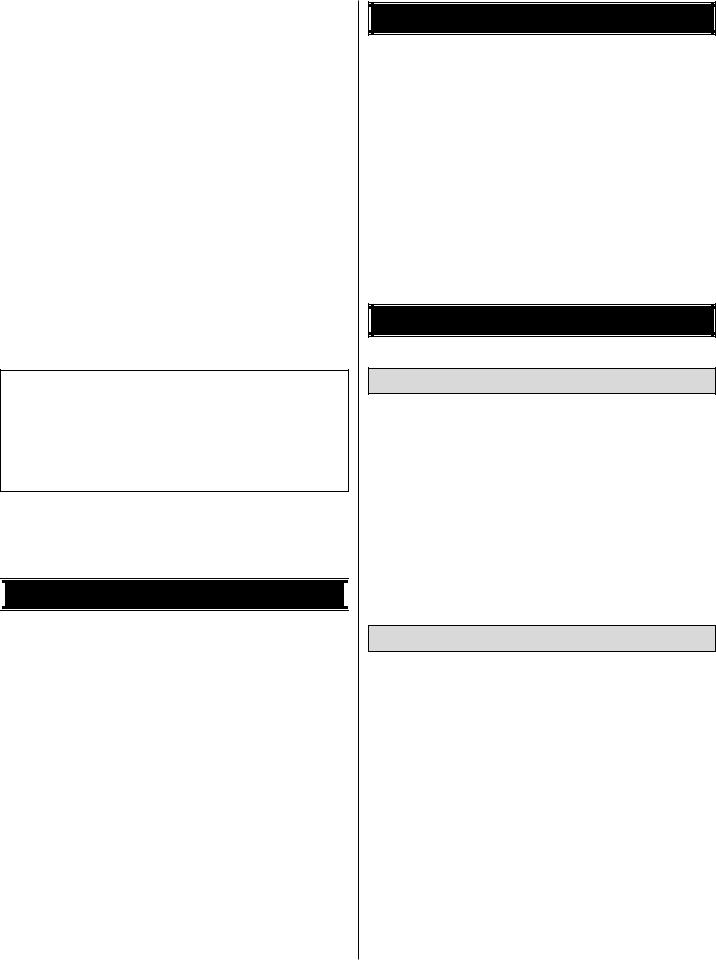
5.You must correctly install all R/C and other components so that the model operates correctly on the ground and in the air.
6.You must check the operation of the model before every flight to insure that all equipment is operating and that the model has remained structurally sound. Be sure to check clevises or other connectors often and replace them if they show any signs of wear or fatigue.
7.If you are not an experienced pilot or have not flown this type of model before, we recommend that you get the assistance of an experienced pilot in your R/C club for your first flights. If you’re not a member of a club, your local hobby shop has information about clubs in your area whose membership includes experienced pilots.
8.While this kit has been flight tested to exceed normal use, if the plane will be used for extremely high-stress flying, such as racing, or if a motor larger than one in the recommended range is used, the modeler is responsible for taking steps to reinforce the high-stress points and/or substituting hardware more suitable for the increased stress.
We, as the kit manufacturer, provide you with a top quality, thoroughly tested kit and instructions, but ultimately the quality and flyability of your finished model depends on how you build it; therefore, we cannot in any way guarantee the performance of your completed model, and no representations are expressed or implied as to the performance or safety of your completed model.
Remember: Take your time and follow the instructions to end up with a well-built model that is straight and true.

 LITHIUM BATTERY HANDLING & USAGE
LITHIUM BATTERY HANDLING & USAGE 

WARNING!! Failure to follow all instructions could cause permanent damage to the battery and its surroundings, and cause bodily harm!
•ONLY use a LiPo approved charger. NEVER use a NiCd/NiMH peak charger!
•NEVER charge in excess of 4.20V per cell.
•ONLY charge through the “charge” lead. NEVER charge through the “discharge” lead.
•NEVER charge at currents greater than 1C.
•ALWAYS set charger’s output volts to match battery volts.
•ALWAYS charge in a fireproof location.
•NEVER trickle charge.
•NEVER allow the battery temperature to exceed 150° F [65° C].
•NEVER disassemble or modify pack wiring in any way or puncture cells.
•NEVER discharge below 2.5V per cell.
•NEVER place on combustible materials or leave unattended during charge or discharge.
•ALWAYS KEEP OUT OF REACH OF CHILDREN.
RADIO EQUIPMENT
•4-channel radio with 3 micro servos such as the Futaba® S3110M with micro plugs (FUTM0702)
•R124F Micro Receiver (FUTL0438 for Low Band, FUTL0439 for high band) with single conversion crystal (FUTL62**) ** selects the channel for your receiver. For example, if you wish to order a channel 35 crystal, you would order FUTL6235
•8A Micro Brushless ESC, such as Silver Series 8A Brushless (GPMM1800)
•RIMFIRE™ 28-22-1380kV Brushless Out-runner Motor (GPMG4505)
•APC 8x3.8 Slo-Flyer prop (APCQ5000)
•350-640mAh 3-cell LiPo battery (GPMP0801 – 350mAh 3-cell, GPMP0805 – 640mAh 3-cell)
ADDITIONAL ITEMS REQUIRED
Adhesives & Building Supplies
This is the list of adhesives and building supplies that are required to finish the Riot 3D ARF.
Great Planes Pro™ thin CA (GPMR6002)
Great Planes Pro medium CA (GPMR6008)
Hobbico® builder’s triangle (HCAR0480)
Hobbico hobby knife (HCAR0100)
#11 Blades for hobby knife (HCAR0211)
Top Flite® panel line pen (TOPQ2510)
Drill bits: 1/16" [1.6mm], 3/16" [4.8mm]
1/2" [13mm] Double-sided foam mounting tape (GPMQ4440)
1" [25mm] Double-sided foam mounting tape (GPMQ4442)
Optional Supplies & Tools
Here is a list of optional tools mentioned in the manual that will help you build the Riot 3D ARF.
Hobbico covering iron (HCAR8000)
21st Century® trim seal iron (COVR2750)
Hobbico heat gun (HCAR7000)
Curved-tip canopy scissors for trimming plastic parts (HCAR0667)
4 oz. [113g] Aerosol CA activator (GPMR634)
Stick-on segmented lead weights (GPMQ4485)
Small T-pins (100, HCAR5100)
2 oz. [57g] Spray CA activator (GPMR6035)
R/C-56 canopy glue (JOZR5007)
CA applicator tips (HCAR3780)
CA debonder (GPMR6039)
Hook & loop material (1" x 6" [25 x 150mm], GPMQ4480)
AccuThrow™ deflection gauge (GPMR2405)
Precision Magnetic Prop Balancer (TOPQ5700)
3
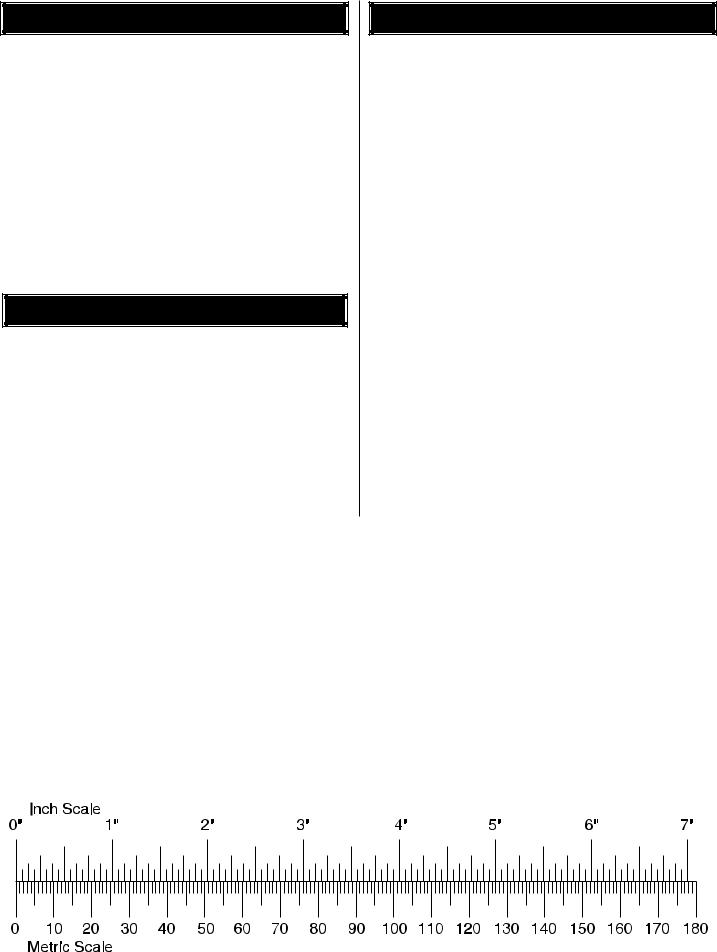
IMPORTANT BUILDING NOTES
•When you see the term test fit in the instructions, it means that you should first position the part on the assembly without using any glue, then slightly modify or custom fit the part as necessary for the best fit.
•Whenever the term glue is written you should rely upon your experience to decide what type of glue to use. When a specific type of adhesive works best for that step, the instructions will make a recommendation.
•Photos and sketches are placed before the step they refer to. Frequently you can study photos in following steps to get another view of the same parts.
COMMON ABBREVIATIONS
Fuse = Fuselage
Stab = Horizontal Stabilizer Fin = Vertical Fin
LE = Leading Edge
TE = Trailing Edge
LG = Landing Gear Ply = Plywood
" = Inches mm = Millimeters
ESC = Electronic Speed Control
METRIC CONVERSIONS
1" = 25.4mm (conversion factor)
1/64" |
= |
.4mm |
3/4" |
= |
19.0mm |
1/32" |
= |
.8mm |
1" |
= |
25.4mm |
1/16" |
= |
1.6mm |
2" |
= |
50.8mm |
3/32" |
= |
2.4mm |
3" |
= |
76.2mm |
1/8" |
= |
3.2mm |
6" |
= |
152.4mm |
5/32" |
= |
4.0mm |
12" |
= |
304.8mm |
3/16" |
= |
4.8mm |
18" |
= |
457.2mm |
1/4" |
= |
6.4mm |
21" |
= |
533.4mm |
3/8" |
= |
9.5mm |
24" |
= |
609.6mm |
1/2" |
= |
12.7mm |
30" |
= |
762.0mm |
5/8" |
= |
15.9mm |
36" |
= |
914.4mm |
4

KIT INSPECTION
Before starting to build, take an inventory of this kit to make sure it is complete, and inspect the parts to make sure they are of acceptable quality. If any parts are missing or are not of acceptable quality, or if you need assistance with assembly, contact Product Support. When reporting defective or missing parts, use the part names exactly as they are written in the Kit Contents list on this page.
Great Planes Product Support 3002 N. Apollo Drive, Suite 1 Champaign, IL 61822 Telephone: (217) 398-8970, ext. 5 Fax: (217) 398-7721
E-mail: airsupport@greatplanes.com
KIT CONTENTS
|
|
|
|
|
|
|
|
|
|
|
|
|
|
|
|
|
|
|
|
|
|
|
|
|
|
|
|
|
|
|
|
|
|
|
|
|
|
|
|
|
|
|
|
|
|
|
|
|
|
|
|
|
|
|
|
|
|
|
Kit Contents |
|
|
|
|
|
|
|
|
|
|
|
|
|
2 |
|
|
|
|
|
|
|
|
|
|
|
|
||||
|
|
|
|
|
|
|
|
|
1 |
|
|
|
|
|
|
|
|
|
|
|
|
|
|
|
|
|
1. |
Fuselage |
|
|
|
|
|
|
|
|
|
|
|
|
|
|
|
|
|
|
|
|
|
|
|
|
|
|
|||||
|
|
|
|
|
|
|
|
|
|
|
|
|
|
|
|
|
|
|
|
|
|
|
|
|
|
|
|
2. |
Canopy |
|
|
|
|
|
|
|
|
|
|
|
|
|
|
|
|
|
|
|
|
|
|
|
|
|
|
|
|||
|
|
|
|
|
|
|
|
|
|
|
|
|
|
|
|
|
|
|
|
|
8 |
|
|
|
|
|
3. |
Landing Gear |
|
|
|
|
|
|
|
|
|
5 |
|
|
|
|
|
|
|
|
|
|
|
|
|
|
|
|
|
||||
|
|
|
|
3 |
|
|
|
|
|
|
|
|
|
|
|
|
|
|
|
|
|
|
9 |
|
|
4. |
Wheels (2) |
||
|
|
|
|
|
|
|
|
|
|
|
|
|
|
|
|
|
|
|
|
|
|
|
|
|
|||||
|
|
|
|
|
|
|
|
|
|
|
|
|
|
|
|
|
|
|
|
|
|
|
|
|
5. |
Center Cabane |
|||
|
|
|
|
|
|
|
|
|
|
|
|
|
|
|
|
|
|
7 |
|
|
|
|
|
|
|
|
|
6. |
Tail Skid |
|
|
|
|
4 |
|
|
|
|
|
|
|
|
|
|
|
|
|
|
|
|
|
|
|
|
7. |
Horizontal Stab & Elevator |
|||
|
|
|
|
|
|
|
|
|
|
|
|
|
|
|
|
|
|
|
|
|
|||||||||
|
|
|
|
|
|
|
|
|
|
|
|
|
|
|
|
|
|
|
|
|
|
|
|
|
|
|
|
8. |
Fin |
|
|
|
|
|
|
|
|
|
|
|
|
|
|
|
|
|
11 |
|
|
|
|
|
|
|
|
||||
|
|
|
|
|
|
|
|
|
|
|
|
|
|
|
|
|
|
|
|
|
|
|
|
9. |
Rudder |
||||
|
|
|
|
|
|
|
|
|
|
|
|
|
|
|
|
|
|
|
|
|
|
|
|
|
|
|
|
10. |
Wing Struts (L&R) |
|
|
|
|
|
|
|
|
|
|
|
|
|
|
|
|
|
|
|
|
|
|
|
|
|
|
|
|||
|
|
|
|
|
|
|
|
|
|
|
|
|
|
|
|
|
|
|
|
|
|
|
|
|
|
|
|
11. |
Bottom Wing |
|
|
|
|
|
|
|
|
|
|
|
|
12 |
|
|
|
|
|
|
|
|
13 |
|
|
|
|||||
|
|
|
|
|
|
|
|
|
|
|
|
|
|
|
|
|
|
|
|
|
12. |
Left Bottom Wing Aileron |
|||||||
|
|
|
|
|
|
|
|
|
|
|
|
|
|
|
|
|
|
|
|
|
|
|
|
|
|
|
|
||
|
|
|
|
|
|
|
|
|
|
|
|
|
|
|
|
|
|
|
|
|
|
|
|
|
|
|
|
13. |
Right Bottom Wing Aileron |
|
|
|
|
|
|
|
|
|
|
|
|
|
|
|
|
|
|
|
|
|
|
|
|
|
|
|
|
14. |
Top Wing |
|
10 |
|
|
|
|
|
|
|
|
|
|
|
|
|
|
|
14 |
|
|
|
|
|
|
|
|
||||
|
|
|
|
|
|
|
|
|
|
|
|
|
|
|
|
|
|
|
|
|
15. |
Left Top Wing Aileron |
|||||||
|
|
|
|
|
|
|
|
|
|
|
|
|
|
|
|
|
|
|
|
|
|
|
|
|
|
|
|
||
|
|
|
|
|
|
|
|
|
|
|
|
|
|
|
|
|
|
|
|
|
|
|
|
|
|
|
|
16. |
Right Top Wing Aileron |
|
|
|
|
|
|
|
|
|
|
|
|
|
|
|
|
|
|
|
|
|
|
|
|
|
|||||
|
|
|
|
|
|
|
|
|
15 |
|
|
|
|
|
|
16 |
|
|
|
|
|
|
|
||||||
|
|
|
|
|
|
|
|
|
|
|
|
|
|
|
|
|
|
|
|
|
|
|
|
|
|
||||
|
|
|
|
|
|
|
|
|
|
|
|
|
|
|
|
|
|
|
|
|
|
|
|
|
|
|
|
|
|
|
|
|
|
|
|
|
|
|
|
|
|
|
|
|
|
|
|
|
|
|
|
|
|
|
|
|
|
|
|
Kit Contents (Not Photographed)
(1)Hardware Bag
(2)12" [305mm] Carbon Rods
(4) 6" [153mm] Carbon Rods
(3) #2 x 3/8" [9.5mm] Self-tapping Screws
(3) #2 Flat Washers
(15) CA Hinges
(2) Wheel Pants
5
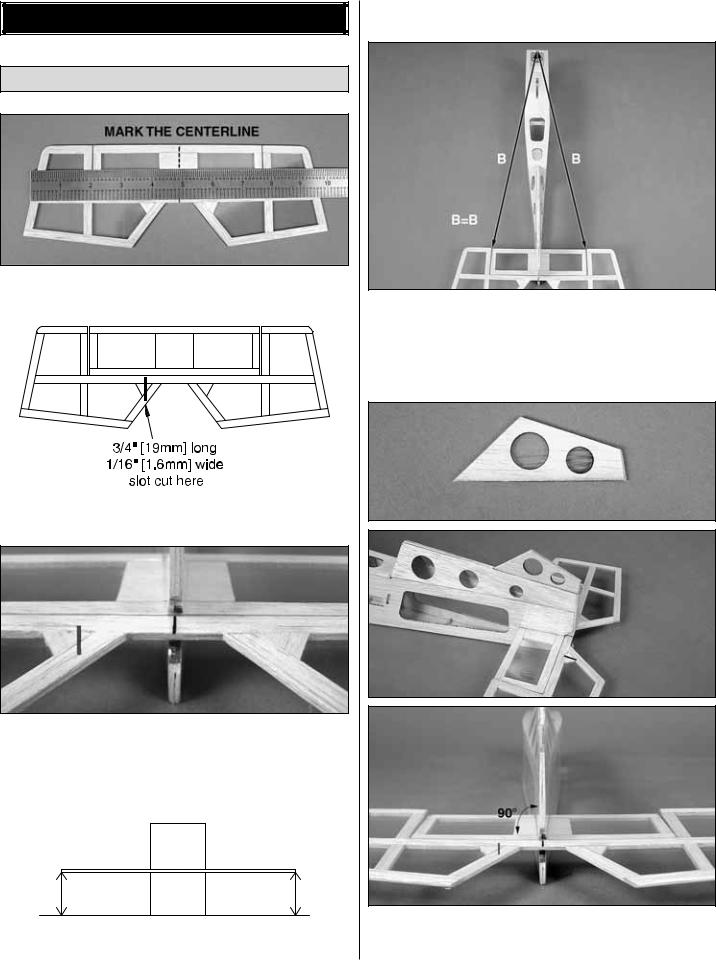
ASSEMBLE THE FUSELAGE
Install the Tail Surfaces
1. Locate the pre-hinged horizontal stab and elevator. Measure and mark the center of the stabilizer as shown.
2. Carefully cut a slot for the elevator control horn in the area marked on the sketch.
3. Insert the stab into the fuselage. Align the mark with the centerline of the fuselage.
A=A
A A
4. With the model sitting on a flat surface, measure the distance from each stab tip to the surface. The measurements
should be equal. Sand the slot in the rear of the fuse as needed for a proper fit.
5. Using a piece of string, measure the distance from the center of the nose of the fuselage to each of the stab tips.These distances must be equal. Mark the stab where it enters the fuselage. Trim the covering from the stab inside the marks.
6. Glue the stab in place once it is aligned with thin CA.
7. Locate the fin. Glue it in place along the centerline of the fuselage as shown. The fin must be perfectly straight up and down and at a 90° angle to the stabilizer.
6
